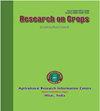两个小麦品种的产量及其成分对叶面喷洒硬脂酸的反应
Q3 Agricultural and Biological Sciences
引用次数: 0
摘要
由于过量使用矿物肥料,导致土壤中污染物积累增加,土壤中存在的元素失衡,从而导致作物产量和质量下降,并给人类和动物带来严重的健康问题、因此,在 2022-2023 年冬季,巴格达大学农业工程科学学院大田作物系附属实验站进行了一项田间试验,旨在研究叶面喷施硬脂酸对小麦产量及其组分的一些性状的影响。研究采用随机整群设计,分块排列,三次重复。研究包括两个因子,第一个因子(主地块)代表两个小麦品种(Buhooth 22 和 Adina),第二个因子(子地块)代表除对照处理(不喷洒)外,喷洒 100、200 和 300 mg/L 三种浓度的硬脂酸。试验结果表明,品种 Buhooth 22 在大多数产量性状上都优于 Adina,平均谷物产量最高,达到 5.38 吨/公顷。关于喷洒硬脂酸的浓度,结果显示浓度为 300 毫克/升的硬脂酸在穗数、千粒重、谷物产量和收获指数方面均优于 300 毫克/升的硬脂酸。浓度 300 毫克/升与浓度毫克/升在大多数性状上没有显著差异,尤其是谷物总产量,达到 5.88 吨/公顷。我们得出结论,Buhooth 22 栽培品种和浓度为 200 毫克/升的硬脂酸效果最好。本文章由计算机程序翻译,如有差异,请以英文原文为准。
Response of yield and its components of two wheat varieties to foliar spraying with stearic acid
As a result of the excessive use of mineral fertilizers, it has led to an increase in the accumulation of pollutants in the soil and an imbalance in the elements present in it , leading to a decrease in crop productivity and quality, in addition to serious health problems for humans and animals, Therefore, attention in recent research has focused on the use of safe and environmentally friendly materials, including stearic acid, Therefore, a field experiment was conducted at Experiments Station affiliated to the Department of field crops, College of Agricultural Engineering Sciences, University of Baghdad during the winter season of 2022-2023, aiming to study the effect of foliar spraying with stearic acid on some traits of yield and its components of wheat. Randomized complete block design within split-plot arrangement with three replications was used. The study included two factors, the first (the main plots) represented two varieties of wheat (Buhooth 22 and Adina), while the second factor in the sub-plot represented spraying with stearic acid at three concentrations of 100, 200, and 300 mg/L, in addition to the control treatment (without spraying). The experiment results showed the superiority of the variety Buhooth 22 to Adina in most yield traits, as the highest average grain yield was recorded at 5.38 t/ha. Regarding the concentrations of the sprayed stearic acid, the results showed the superiority of the concentration 300 mg/L in number of spikes, weight of 1000 grain, grain yield, and harvest index. The concentration 300 mg/L didn’t differ significantly with the concentration mg/L in most traits, especially the total grain yield, which amounted to 5.88 t/ha. We conclude that Buhooth 22 cultivar and stearic acid with 200 mg/L concentration recorded the best results.
求助全文
通过发布文献求助,成功后即可免费获取论文全文。
去求助
来源期刊

Research on Crops
Agricultural and Biological Sciences-Soil Science
CiteScore
1.50
自引率
0.00%
发文量
93
审稿时长
1 months
期刊介绍:
The Research on Crops is a peer-reviewed journal publishing original research papers, review articles and short communications in English on all basic and applied aspects of crop sciences, agricultural water management, agro-climatology, agroforestry, agronomy, crop production, crop protection, cropping systems, food science & technology, genetics & plant breeding, horticulture, plant & soil science, plant biotechnology, plant nutrition, post-harvest management of crops, seed science, soil management & tillage, vegetables, weed science, agricultural engineering, agri-business, agricultural economics and extension, etc. The aim of the journal is to provide a forum for the scientific community to publish their latest research findings.
The manuscripts submitted for publication should not contain data older than 4 years on the date of submission.
The articles submitted for publication in this journal should not be submitted elsewhere simultaneously for publication in another journal. These should not carry any copyright material without prior permission of copyright holder.
The articles should present a complete picture of the investigation made and should not be split into parts.
There is no prescribed limit regarding the number of pages in case of full-length articles. However, the authors are advised to keep the length of their articles from 4 to 10 full printed pages of the journal.
The articles should be divided into the sub-sections: ABSTRACT, INTRODUCTION, MATERIALS AND METHODS, RESULTS AND DISCUSSION, CONCLUSIONS, and REFERENCES. Tables and figures should be appended separately at the end.
 求助内容:
求助内容: 应助结果提醒方式:
应助结果提醒方式:


